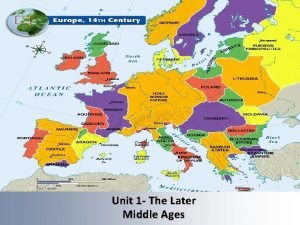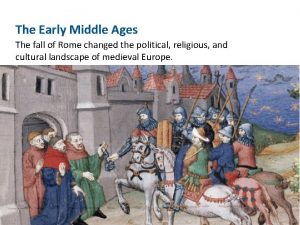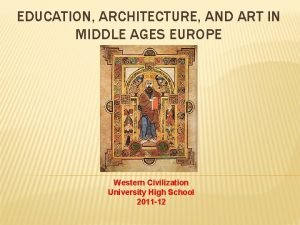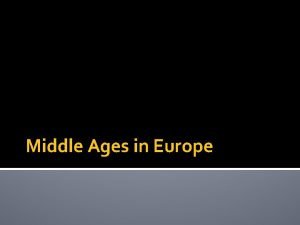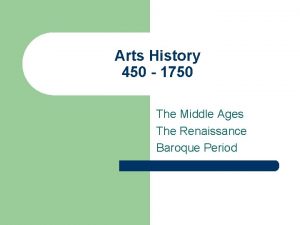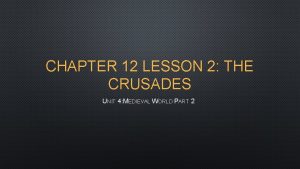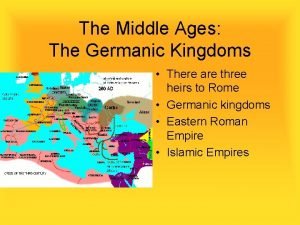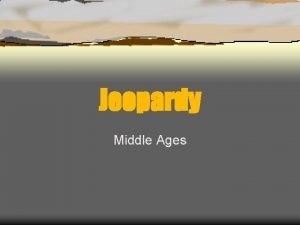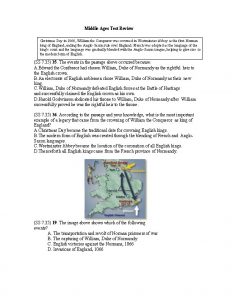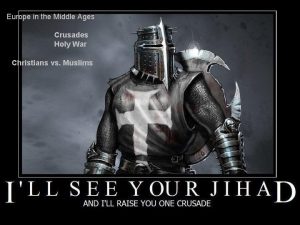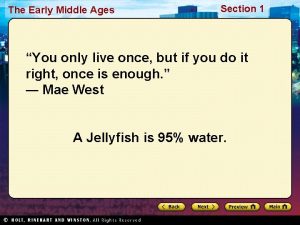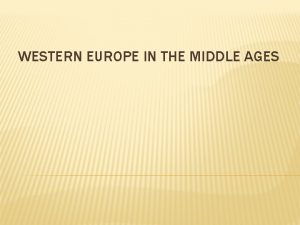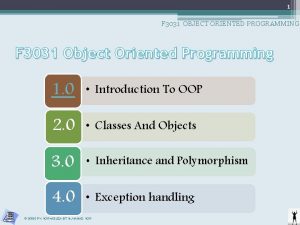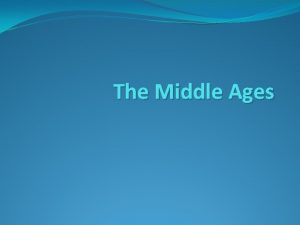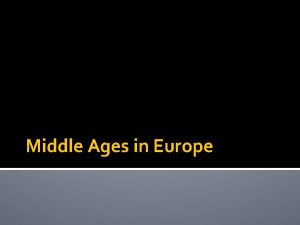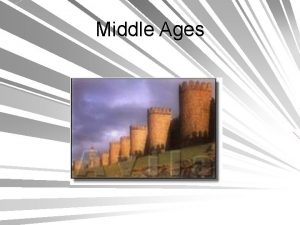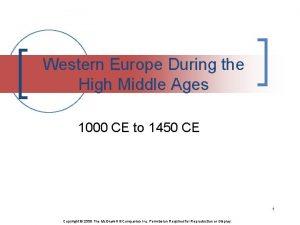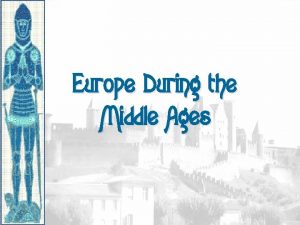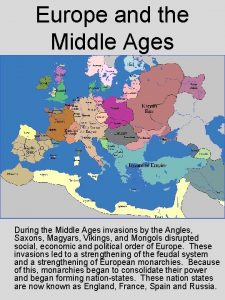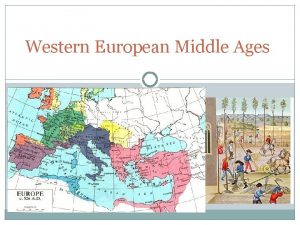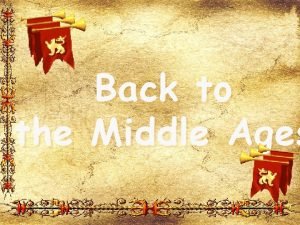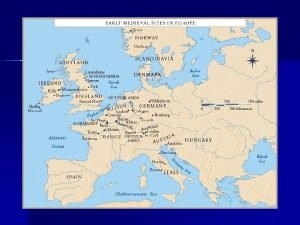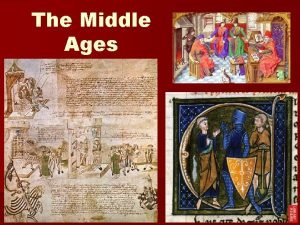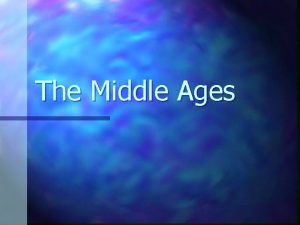Western Europe During the Middle Ages pg 3031






















- Slides: 22

Western Europe During the Middle Ages pg. 30&31 LG 1: Explain how Roman Catholicism and Eastern Orthodoxy were unifying social and political forces in Western Europe and Byzantine Europe and identify the impact of ideas contained in Justinian’s Code of Laws.


The West Life after the fall of The Roman Empire • • • Western Rome falls to barbarian invaders in 476 A. D. Europe was left with no central government & no system of defense Invading groups set up kingdoms throughout the west These kingdoms were often at war with one another Most powerful rulers had the most land & best warriors


The Role of the Church The Christian church survived the fall of Rome The church was the only thing remaining that provided order and security to the people in the west

Clovis & The Franks • • The Franks established the largest of the Germanic kingdoms in what is now known as France (that’s how France got its name) Clovis: • leader of the Franks • brought Christianity to the region • • With the help of the newly converted Franks, Christianity continued to spread through out the region Ruled for 30 years and greatly expanded their empire

Background… “According to legend, his wife, Clothilde, had urged him to convert to her faith, Christianity. In 496, Clovis led his warriors against another Germanic army. Fearing defeat, he appealed to the Christian God. “For I have called on my gods, ” he prayed, “but I find they are far from my aid. . Now I call on Thee. I long to believe in Thee. Only, please deliver me from my enemies. ” The tide of the battle shifted and the Franks won. Afterward, Clovis and 3, 000 of his warriors asked a bishop to baptize them. The Church in Rome welcomed Clovis’s conversion and supported his military campaigns against other Germanic peoples. By 511, Clovis had united the Franks into one kingdom. The strategic alliance between Clovis’s Frankish kingdom and the Church marked the start of a partnership between two powerful forces. ” Glencoe Book

Charles Martel Leader of The Franks after the death of Clovis United the Franks Wasn’t the king… ‘Mayor of the palace’ 732 AD - Defeated the Moors (Muslims) at the Battle of Tours and kept them from invading If Charles Martel had not defeated the Moors Western Europe may have become part of the Islamic Empires and therefore may still have practiced Islam today

Charlemagne • • • After Charles Martel’s death his son Pepin took over – he was appointed King by the pope When he died, his son Charlemagne took over Charlemagne: • Most important leader of the Franks – Ruled 768 -814 A. D. – Encouraged education & scholarship – Unified Christian land in Europe into one single empire – Holy Roman Empire

Charlemagne Built his empire with the help of Pope Leo III (leader of the Roman Catholic Church) Pope crowned him “Holy Roman emperor” in 800 C. E. After his death the Holy Roman Empire fell apart ◦ Holy Roman Empire – the area controlled and ruled by Charlemagne http: //www. history. com/topics/charlemagne/videos/the-reign -of-charlemagne

Division of Charlemagne’s Empire New threats emerged ◦ ◦ Slavs Magyars Muslims Vikings

Chaos led to… With the destruction of Charlemagne’s empire there was not system in place to fight off attack… FEUDALISM emerged - A system of military service in exchange for land!

The Byzantine Empire LG 1: Explain how Roman Catholicism and Eastern Orthodoxy were unifying social and political forces in Western Europe and Byzantine Europe and identify the impact of ideas contained in Justinian’s Code of Laws.

Byzantine Empire 500 to 1453 C. E. After the fall of Rome, the eastern empire continued for another 1, 000 years. We call this the Byzantine Empire, after Byzantium, the original name of its capital city Much more stable than the west Emperor Constantine moved the capital city to Byzantium and renamed it Constantinople The eastern half of Rome thrived & survived (Byzantine) and the western half did not


Constantinople Why was Constantinople chosen as the capital city? ◦ Easy to defend; surrounded by water on 3 sides ◦ Located on many of the major trade routes ◦ At its height more than a million people lived there and many people found wealth through trading goods (luxury items)

Justinian, 518 -565 C. E. Important Byzantine Emperor

Justinian’s Reign One of the greatest Byzantine Emperors – Justinian Wife – Theodora Rebuilt the empire after a revolt Built the Hagia Sophia – grand church Reconquered parts of North Africa, Italy, and Spain Created a systematic body of laws – Justinian’s Code ◦ Became the basis for many law codes in the western world today

Hagia Sophia

Byzantine Empire organized through a bureaucracy Officials were trained in Hellenistic classics (remember Greek influence) Regulated trade, taxes, and prices of goods Western Empire – spoke Latin Byzantine Empire – spoke Greek

Byzantine Empire Before the fall of the Western Roman Empire ◦ 2 Emperors ruled – one in Rome & one in Constantinople Remained connected through their shared Christian faith - until the church in the east (Byzantine) developed their own ways of doing things ◦ Eastern Orthodox Church

Split of the Christian Church Byzantine Empire – ◦ Began Eastern Orthodox Church Western Europe – ◦ Continued to practice Catholicism
 Dark ages def
Dark ages def Renaissance art vs medieval art
Renaissance art vs medieval art European middle ages map
European middle ages map Art in emerging europe
Art in emerging europe Around 900 ce a new form of government called
Around 900 ce a new form of government called Rfc 3031
Rfc 3031 Sel-3031
Sel-3031 Rfc 3031
Rfc 3031 Early middle ages
Early middle ages Egyptian floral designs
Egyptian floral designs Education in middle ages
Education in middle ages Middle ages def
Middle ages def High middle ages
High middle ages Middle ages nobles
Middle ages nobles The middle ages outcome the power of the church
The middle ages outcome the power of the church Chapter 12 lesson 4 the late middle ages
Chapter 12 lesson 4 the late middle ages Germanic kingdoms in the middle ages
Germanic kingdoms in the middle ages Middle ages study guide answer key
Middle ages study guide answer key Middle ages jeopardy
Middle ages jeopardy Middle ages test review
Middle ages test review Middle ages
Middle ages Middle ages nobles
Middle ages nobles The middle ages 1066 to 1485 unit introduction
The middle ages 1066 to 1485 unit introduction


